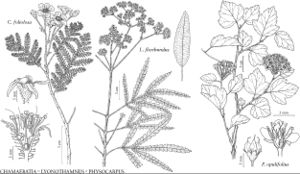Physocarpus
New Fl. 3: 73. 1838.
| Taxon | Illustrator ⠉ | |
|---|---|---|
 | Chamaebatia foliolosa Lyonothamnus floribundus Physocarpus opulifolius | Marjorie C. Leggitt Marjorie C. Leggitt Marjorie C. Leggitt |
Shrubs, (10–) 30–60 dm, glabrous or stellate-hairy, mostly eglandular (except in inflorescence). Stems 5–20, ascending to erect, branches erect proximally, somewhat sinuous; bark buff to reddish-brown or black, usually peeling in narrow strips; short-shoots present; buds superposed, each with ca. 5 exposed brown scales. Leaves deciduous, cauline; stipules caducous, decurrent on stem, leaving oblique, broadly ovate to rectangular stubs, linear or oblong to narrowly ovate, obovate, or elliptic, sometimes rhombic, margins sometimes remotely glandular-dentate, surfaces sparsely stellate-hairy (glabrous adaxially in P. monogynus); petiole present; blade broadly ovate to obovate or orbiculate, 0.5–10 cm, membranous, margins flat, crenate to doubly crenate or doubly dentate, 3–5 (–7) -lobed, rarely almost unlobed, 3–5 (–7) -veined, surfaces glabrous or sparsely to densely stellate-hairy. Inflorescences terminal or axillary on leafy short-shoots, 5–50-flowered, open to dense corymb or umbellike pedunculate racemes; bracts present; bracteoles absent. Pedicels present. Flowers 5–12 mm diam.; hypanthium cupshaped to campanulate, 1.5–3 mm, exterior stellate-hairy; sepals 5, ascending to slightly reflexed, triangular to ovate; petals 5, white to pale-pink, broadly obovate, elliptic, or orbiculate, base short-clawed, sometimes irregularly toothed or notched; stamens 20–40, shorter than, equal to, or exceeding petals; carpels 1–5; styles slender, stigmas capitate; ovules 2–5. Fruits aggregated follicles, sometimes solitary, 1–5, ovoid, often ± inflated, slightly flattened, size not recorded, splitting along both sutures; hypanthium persistent; sepals persistent, ascending to slightly reflexed. Seeds 1 (–5), shiny yellow, carunculate. x = 9.
Distribution
North America, n Mexico, ne Asia, in Europe
Discussion
Species 8–10 (6 in the flora).
Some species of Physocarpus are not well delimited. Some botanists have confused Physocarpus and Neillia (including Stephanandra); Physocarpus is distinguished by its rounded umbel-like racemes and bladderlike fruits splitting along both sutures; in Neillia, the inflorescences are longer and narrower, and the fruits split along the adaxial suture. As currently understood, Neillia is an Asian genus. Two or three species of Physocarpus are widely cultivated in North America and Europe; the others are less commonly seen though they may be worthy of more attention.
Opulaster Medikus ex Kuntze is an illegitimate, superfluous name that pertains here.
Selected References
None.
Lower Taxa
Key
| 1 | Carpels 3–5, connate basally | > 2 |
| 1 | Carpels 1 or 2(3), if 2(3), connate 1/2 their lengths | > 4 |
| 2 | Carpels densely stellate-hairy (sometimes only on sutures); follicles densely stellate-hairy (sometimes only on sutures). | Physocarpus intermedius |
| 2 | Carpels mostly glabrous, sometimes hairy (on ventral sutures) or sparsely stellate-hairy, glabrescent; follicles glabrous or sparsely stellate-hairy, ± glabrescent | > 3 |
| 3 | Follicle lengths ca. 2 times sepals; leaves usually longer than wide; racemes open. | Physocarpus opulifolius |
| 3 | Follicle lengths slightly exceeding sepals; leaves usually as wide as long; racemes dense. | Physocarpus capitatus |
| 4 | Leaves 0.5–2 × 0.5–2 cm; carpels 1(2); stamens unequal (alternately long and short). | Physocarpus alternans |
| 4 | Leaves 1.5–6 × 2–6 cm; carpels usually 2(3); stamens ± equal | > 5 |
| 5 | Stipules oblong to elliptic or obovate, apices of some rounded or erose, 6 × 2.5 mm; follicles flattened, keeled apically. | Physocarpus malvaceus |
| 5 | Stipules linear to narrowly elliptic or subulate, apices acute, 4–5 × 1 mm; follicles inflated, not keeled apically. | Physocarpus monogynus |
"thin" is not a number."dm" is not declared as a valid unit of measurement for this property.